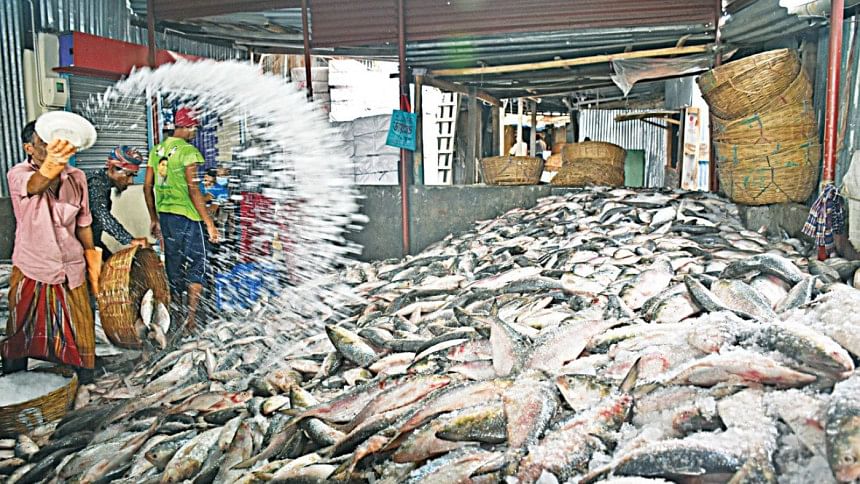Fish consumption could be the answer to malnourishment in Bangladesh

Bangladesh is currently considered among the top 10 fish producing countries in the world. The country has found tremendous success in freshwater aquaculture with an increased rate of production over the last decade.
With more hilsa production and increased harvest of marine fisheries, it is possible to continue to increase the overall production volume and variety of fish for domestic consumption and export earnings.
Fish, both capture and culture, collectively constitute as a primary pillar for our national food and nutrition security.
Despite increased fish production and agricultural growth, Bangladesh has yet to ensure a population that is fully nourished and healthy.
It is unfortunate that our people suffer from "silent hunger" (or malnourishment) despite of an abundant supply of fish and food in the markets.
Around 20 million women and children are malnourished, either suffering from anemia (women) or stunting (children and adolescents). Their food consumption does not have the nutrients required to keep them healthy.
By selecting fish species, flexible and improved supply chain, creating awareness through nutrition education and guaranteed portion size in diets for the vulnerable population, it is possible to eliminate malnourishment from Bangladesh.
With 4.3 million metric tons production, the country has successfully surpassed the target of 60g per capita recommended consumption with 63g per capita availability.
Currently the country is able to produce enough fish to cover the population's nutrition needs.
The major proportion -- 56 percent -- of this production comes from aquaculture. Majority of these aquaculture farms are located in rural areas and a good part of it comes from household ponds as well.
While 63g per capita fish is now available, anecdotal evidence suggests that the average daily consumption of fish in rural and urban poor households is much less than the national average. This affects their nutrition needs.
As such efforts should be taken to improve accessibility, affordability, storage, quality and utility of the fish produced.
Food security and nutrition has risen to the top of the global priority agenda and stands as Sustainable Development Goal-2: "to end hunger, achieve food security and improved nutrition".
Food security is considered as the availability and affordability of food for everyone in a country.
Due to efforts of the government for a decade, the prevalence of being severely underweight among children has dropped down from 31.9 percent in 2012 to 22.6 percent in 2019. The level of moderate to severe stunting has gone down from 42 percent in 2012 to 28 percent in the same period. At least 39 percent women suffer from malnourishment.
High level of malnutrition occurs among pregnant women, new mothers, and children who have limited access and priority to food containing essential micro-nutrients. Fish consumption can change this scenario in the country.
Increased consumption of specific fish species can deliver micro-nutrients, essential minerals, protein and boost immunity for people of all age groups. Some inland fish like mola, dhela, darkina, chela, and all pelagic marine fishes are rich in micro-nutrients and other essential elements that support normal growth of children, development of brain and cognition, and may reduce anemia amongst women.
Small fish are rich in essential fatty acids and micro-nutrients like calcium, iron, zinc, iodine, vitamin A and vitamin B12. We need to emphasise on diversification in aquaculture species to include nutrient-rich indigenous small fishes for enriching diet. Fish is a vital source of nutrient-dense high-quality protein, low chain polyunsaturated fatty acids and micro-nutrients, and thus fish consumption can combat malnutrition and help boost community health.
Despite tremendous success in aquaculture of carps, pangas and tilapia production, rural and urban people are deprived of the heritage of nutrient-rich small fish. These fish were once abundant in inland waterbodies, available for free harvesting. Through breeding success at the BFRI and private hatcheries, fish seeds of many small local species are now available. We should now promote innovative nutrient-sensitive aquaculture, that is, small fish with carps, tilapia in small scale ponds and rice fields. Small fish can be consumed by the family, and large fish sold for household income.
Department of Fisheries (DOF), Bangladesh Fisheries Research Institute (BFRI) and Bangladesh Agricultural University, INGOs and NGOs may develop science-based nutrition-sensitive aquaculture technologies, which will be nutritionally important, economically beneficial, socially acceptable, and environmentally benign.
Good facilities such as cold storage, fish drying, salting, ice and transportation for culture fish, marine fish and hilsa distribution throughout country is necessary. This will result in reducing waste, swift availability and ensure even market distribution. We should improve local fish markets and set up market hubs in major fish producing and landing sites.
Trishal (in Mymensingh) wholesale fish market may be an example of such fish hubs. Thirty to forty such hubs throughout the country can be set up in important fish producing sites. Fish markets should have improved storage facility, clean ground water, electricity and improved cold chain. Bangladesh Fisheries Development Corporation (BFDC) could play a leading role in this regard.
Fish can be included in school feeding programmes. Hospitals may provide fish in regular patient diet.
More work is required to promote fish as an active part of our diet that provides all essential nutrients, minerals, and protein. Selecting the right species of mineral and nutrient rich fish for production, creating an efficient fish distribution supply chain, fish promoted as staple, and proper nutrition education will finally help our country break the malnourishment barrier.
Md Abdul Wahab, PhD, is a retired Professor of Fisheries from Bangladesh Agricultural University and is currently the team leader of the ECOFISH II project at World Fish Bangladesh. He can be reached at [email protected]

 For all latest news, follow The Daily Star's Google News channel.
For all latest news, follow The Daily Star's Google News channel. 



Comments